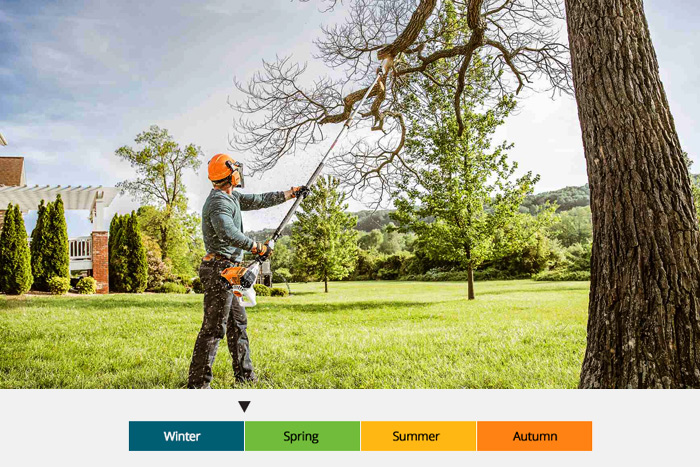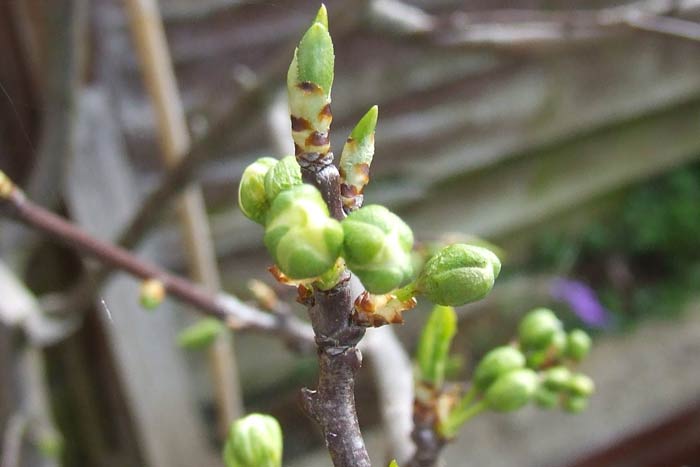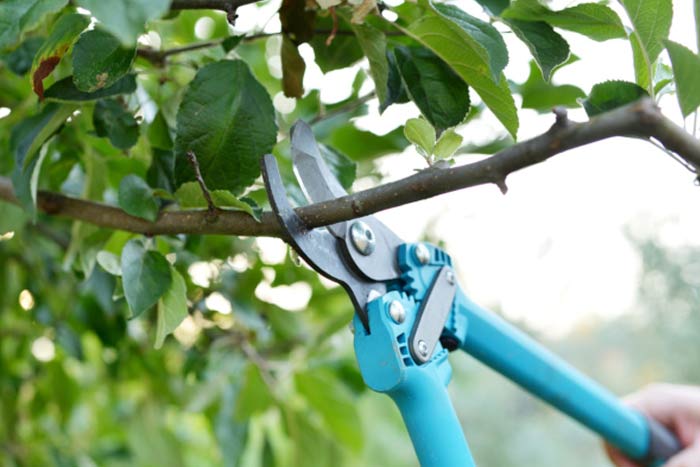Almost every tree growing in your yard may need to be trimmed at some point. Tree trimming helps maintain tree health, reduces the risk of damage to nearby structures, and improves the tree’s overall curb appeal. Knowing when to trim your tree is crucial for your trees health and longevity.
Spring is the best time of year to trim most trees. Trees respond best to large changes while they are still relatively inactive in early spring while coming out of their winter dormancy. They will also have a full season of growth to heal wounds before shutting down again next winter. Pruning during the cooler months also allows trees to partially seal wounds with ap before pests and diseases like borer or oak wilt are more active in hotter weather.

What we cover
ToggleWhat Species of Trees Can You Prune in Spring?
Trees have different leafing and growth schedules and should be pruned when there is a great chance that they will stay healthy. Unless you are trimming old or decaying branches off, pruning before a storm or cyclone, then you should only trim the following trees in spring and at the right time:
Apple trees

Apple trees and most fruit trees should be trimmed every other year. You should trim towards the end of winter or the beginning of spring. This will give them a stronger boom and a larger fruit harvest as the tree will have more resources to put towards fruit growth rather than maintaining extra branches and foliage.
When pruning you should first focus on dead branches as well as live branches that are growing in towards the center of the tree rather than outwards. You should also focus your attention on the second and third-order branches and not remove important scaffold branches. Also, limit pruning to 30 -40 % of foliage each time.
Peach trees

Peach trees need annual trimming which is more frequent than any other fruit tree. This can be pruned in the early parts of spring to allow new leaves to develop and maintain branch health and density. If left unattended, peach trees tend to develop issues with the quality of fruit. You should aim to remove at least half of the past year’s new branches. Pruning peach trees in early spring is done to reduce the number of fruit, which will lower the yield, but increase the quality of the harvest.
Peach trees should ideally be pruned every spring and should be pruned to an open center shape. This will keep the density and branch height short for optimal production and overall health.
Cherry trees

Cherry trees should also be pruned at the early stages of spring or at the very last stages of the winter season every year to maintain health and fruit production. Pruning the cherry trees will encourage new fruit-producing branches to grow.
Which Trees Should Never Be Pruned in Spring?
Some trees should not be trimmed in the spring because of their growth patterns, susceptibility to disease, and other factors. Here are some of them:
Oak trees

Oak trees should only be trimmed in the winter because they tend to get infected by a disease known as oak wilt. Trimming them in the spring is a bad idea because of the number of bugs that are usually more active in the warm spring weather. The bugs will feed on the fresh sap that is left exposed after fresh trimming and eventually infect and kill large chunks of the oak thus preventing growth and probably killing the tree in the long run.
Restrict the trimming to old or half-dead branches if the oak tree is less than three years in age and trim older trees to desired shapes but avoiding foundational branches that are connected directly to the main trunk.
Elm trees

Elm trees should be trimmed towards the end of winter or in the very early days of spring. This is to prevent elm bark bees that are attracted by the scent of freshly cut bark and may infect the elm tree with Dutch elm disease.
Other trees that should not be trimmed in the spring include:
- Barberry
- Chokecherry- early bloomer
- Magnolia- early bloomer
- Apricot
- Sycamore
- Honey locust, among others
| Trees that should be pruned in Spring | Trees that should not be trimmed in the spring |
|---|---|
| Apple trees | Oak |
| Cherry trees | Elm |
| Peach trees | Chokecherry |
| Trumpet vine | Magnolia- |
| Wisteria | Apricot |
| Lilac | Sycamore |
| Virginia creepers | Honeylocust |
| Forsythia | |
| Flowering dogwood | |
| Clematis |
How Late into Spring Can I Trim A Tree?

While this depends on the tree and its flowering and growing patterns, pruning in spring should be limited to the early to middle part of the season. Pruning too late into the season might hinder the tree’s growth and restrict blooming. Fruit trees should especially be pruned in the early parts of spring to allow the buds to develop on fully healthy and well-spaced branches for better quality fruit and easier harvesting.
Should you find it necessary to prune later in spring, then you should be more cautious about the cuts and the amount of pruning you do. You should only prune dead or weak branches when it’s necessary for late spring.





Can You Prune After A Tree Has Leaves and Buds on Them?
Trees and bushes that are trimmed in spring usually have fully developed leaves and may have started budding at that time. It’s therefore okay to prune a tree while it is leafing and developing buds in the early to middle parts of spring. You should, however, be careful not to cut too many fresh leaves and buds as this might affect growth. Pruning a tree at this point should be done to control growth, shape the tree, and remove dead plant matter.
When Is It Too Late to Trim Trees?
It’s generally not a good idea to trim or prune most trees in the summer or fall. This is mainly because most trees are either dormant or shedding leaves at this point and therefore pruning or trimming will not encourage new growth and may not have the best results. As a practical example, pruning for aesthetic purposes in fall will not produce the best results because the tree has already shed its leaves and cannot be shaped as needed.
Is Safety an Issue When Pruning Trees?
Safety is one of the main reasons why trees, especially large shade trees, should be trimmed regularly. Dead or dry branches can become dangerous projectiles that destroy nearby installations and objects such as windows, roofs, etc. Tree trimming is one of the ways you can prepare your compound for an impending tropical storm or cyclone.
How Much Should I Trim Off in Spring?
While it depends on the tree you are trimming, it is advisable not to trim more than 10% of a tree in spring. Also avoid trimming large, healthy branches that form the main framework of the tree.

Fall trimming is not effective because it does not encourage new growth. Most trees will be shedding their leaves in fall and are not actively growing. However, it can be easier to identify dead or diseased branches in fall as there are no leaves in your way.
Yes, most fruit trees are trimmed in the early parts of spring to reduce bulk (fruit thinning) and to shape the fruit tree. However, be extra cautious when trimming a fruit tree in spring so as not to destroy developing buds and reduce yield.
Summer trimming is generally not a good idea because there is no fresh growth and some, otherwise healthy branches might appear dry in the hot summer.







